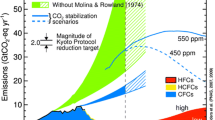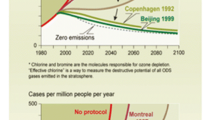Abstract
The Montreal Protocol is the most successful global environmental agreement in history and a shining example of a current generation taking extraordinary precaution in avoiding environmental impacts to future generations. The delayed methyl bromide phaseout, however, alerts us to serious problems that can arise—even in this extraordinary agreement—when actors are allowed to place profit and political concerns over precautionary ones. This is not to say that ozone layer protection is anti-profit for participating companies, governments, and scientific groups or that early successes were not rife with political and economic concerns. The history of this agreement shows us that such concerns existed (see Andersen, this issue; Andersen and Sarma 2002; Gareau 2010). Nevertheless, early successes were found by assuring that the precautionary principle was applied first and foremost in ozone diplomacy (see also Andersen, this issue). The language found in the Protocol’s critical use exemptions to the methyl bromide phaseout in particular illustrates how this important principle was swept aside, as was concern for the global environment, and concerns for corporate profit took its place. While this abuse has occurred only once in the Montreal Protocol’s history, it is important to learn the lessons from this low point in ozone layer politics so that similar mistakes are not made with regard to other important global environmental issues, specifically global climate change.

Similar content being viewed by others
Notes
“In order to protect the environment, the precautionary approach shall be widely applied by States according to their capabilities. Where there are threats of serious or irreversible damage, lack of full scientific certainty shall not be used as a reason for postponing cost-effective measures to prevent environmental degradation.” http://www.un.org/documents/ga/conf151/aconf15126-1annex1.htm.
Personal communication with Stephen O. Andersen, 23 October 2014.
References
Andersen SO, Sarma KM (2002) Protecting the ozone layer: the United Nations history. Earthscan, London
Andersen SO, Zaelke D (2003) Industry genius. Greenleaf Publishing, Sheffield
Banks J (1998) Methyl bromide technical options committee. In: LePrestre PG, Reid JD, Morehouse ET Jr (eds) Protecting the ozone layer: lessons, models and prospects. Kluwer, Boston, pp 167–172
Benedick RE (1998) Ozone diplomacy: new directions in safeguarding the planet. Harvard University Press, Cambridge
Canan P, Reichman N (2002) Ozone connections: expert networks in global environmental governance. Greenleaf, Sheffield
Bernstein S (2002) The compromise of liberal environmentalism. Columbia University Press, New York
Downie D (2014) Stratospheric ozone depletion. In: Harris P (ed) Routledge handbook of global environmental politics. Routledge, New York, pp 373–387
DuPuis EM, Gareau BJ (2008) Neoliberal knowledge: the decline of technocracy and the weakening of the Montreal Protocol. Social Science Quarterly 89(5):1212–1229
Gareau BJ (2010) A critical review of the successful CFC phase-out versus the delayed methyl bromide phase-out in the Montreal Protocol. International Environmental Agreements: Politics, Law, and Economics 10(3):209–231
Gareau BJ (2012) The limited influence of global civil society: international environmental NGOs and the methyl bromide controversy in the Montreal Protocol. Environmental Politics 21(1):88–107
Gareau BJ (2013) From precaution to profit: contemporary challenges to environmental protection in the Montreal Protocol. Yale University Press, New Haven
The Guardian (2014) Three new ozone-depleting gases discovered in Atmosphere. The Guardian Press, 4 June, available at: http://www.theguardian.com/environment/2014/jun/04/three-new-ozone-depleting-gases-discovered-in-atmosphere
Hunter D, Salzman J, Zaelke D (2007) International environmental law and policy. Foundation Press, New York
Litfin K (1994) Ozone discourses: science and politics in global environmental cooperation. Columbia University Press, New York
Mayfield EN, Norman CS (2012) Moving away from methyl bromide: political economy of pesticide transition for California strawberries since 2004. Journal of Environmental Management 106:93–101
Norman CS (2005) Potential impacts of imposing methyl bromide phaseout on U.S. strawberry growers: a case study of a nomination for a critical use exemption under the Montreal Protocol. Journal of Environmental Management 75(2):167–176
Acknowledgments
Special thanks to Penelope Canan, Nancy Reichman, Nancy Sherman, Stephen O. Andersen, and Durwood Zaelke for comments on this paper and topic and to all who participated in the plenary session discussion at the follow-up session, “The Montreal Protocol at the Crossroads,” at the 2014 meeting of the Association for Environmental Studies and Sciences (AESS). My participation in the AESS was made possible by Boston College. Figure 1 is a Joel Pett Editorial Cartoon used with the permission of Joel Pett and the Cartoonist Group. All rights reserved.
Author information
Authors and Affiliations
Corresponding author
Rights and permissions
About this article
Cite this article
Gareau, B.J. Lessons from the Montreal Protocol delay in phasing out methyl bromide. J Environ Stud Sci 5, 163–168 (2015). https://doi.org/10.1007/s13412-014-0212-x
Published:
Issue Date:
DOI: https://doi.org/10.1007/s13412-014-0212-x




